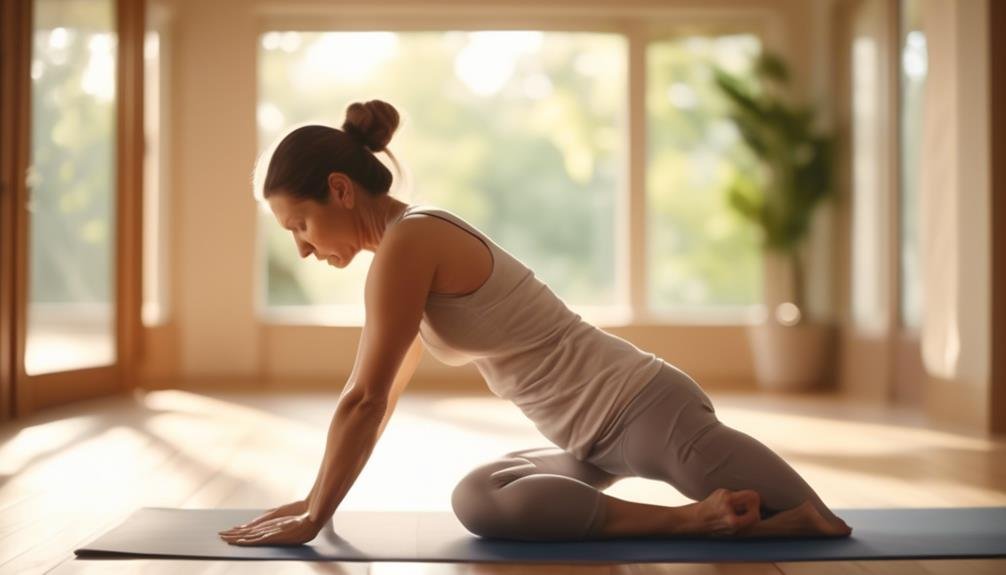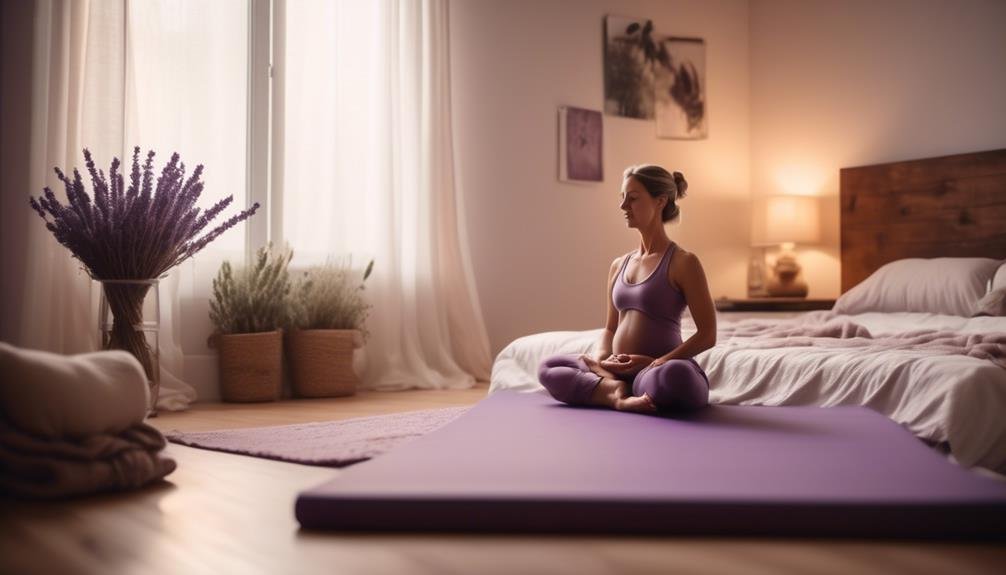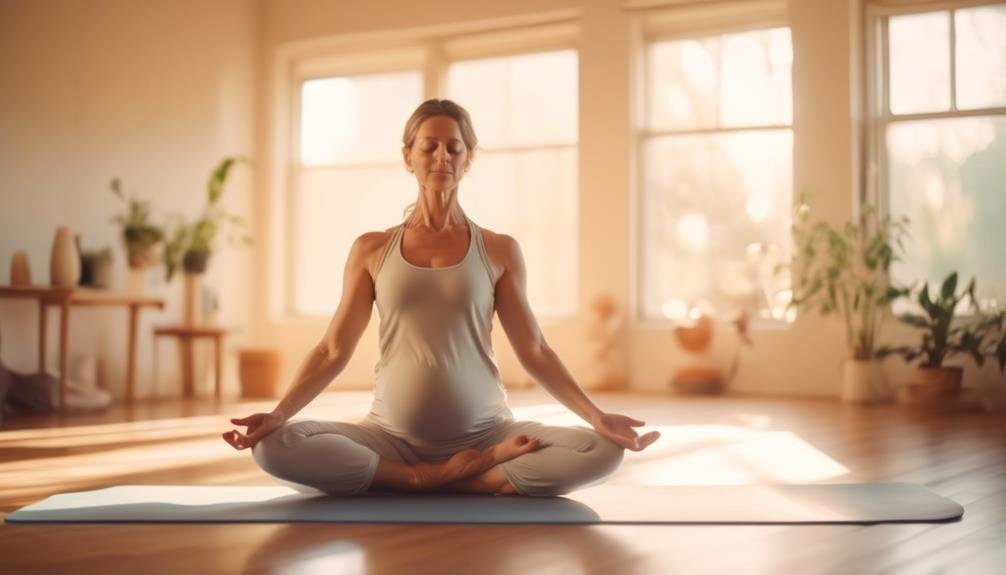"Cherishing Little Steps - A Haven for Baby and Family Journeys"
Yoga for Postnatal Well-being
Imagine your body as a delicate flower, gracefully blossoming after the storm of childbirth. Just as a flower needs nurturing and care to thrive, so do you, new mom.
In this fast-paced world, it is easy to overlook the importance of self-care amidst the chaos of motherhood. But fear not, for yoga has emerged as a gentle yet powerful tool to support your postnatal well-being. Whether you are seeking physical recovery, emotional balance, or a deeper connection with your body, the practice of postnatal yoga holds countless benefits.
So, take a moment to pause, breathe, and explore the transformative potential of yoga on your journey to reclaiming your well-being.
Key Takeaways
- Postnatal yoga offers numerous benefits for new moms, including reducing stress, anxiety, and symptoms of postpartum depression.
- Suitable yoga poses for new moms include cat-cow pose, bridge pose, and child's pose, which help strengthen core muscles and promote relaxation.
- Incorporating breathing exercises into the postnatal routine aids in recovery, reduces stress, and provides effective techniques for stress relief and anxiety reduction.
- Pelvic floor exercises are crucial for postpartum recovery, improving bladder control, enhancing intimacy, and toning and tightening muscles. Consistency and gradual progression are key for optimal results.
Benefits of Postnatal Yoga

Postnatal yoga offers numerous benefits to help you regain strength, promote relaxation, and foster overall well-being after giving birth. It's essential to choose suitable yoga poses for postnatal recovery. These poses won't only help to rebuild your physical strength but also provide mental and emotional support during this transformative time in your life.
One of the major benefits of postnatal yoga is its positive impact on your mental health. Yoga has been proven to reduce stress, anxiety, and symptoms of postpartum depression. By practicing yoga, you can create a safe space to connect with your body and release any emotional tension that may arise after childbirth. The deep breathing exercises and gentle movements in postnatal yoga help to calm your mind, promote relaxation, and increase feelings of overall well-being.
Additionally, postnatal yoga helps to strengthen your core muscles, which can become weakened during pregnancy and childbirth. Certain poses, such as the cat-cow stretch and pelvic tilts, target and activate the deep abdominal muscles responsible for stabilizing your spine. By incorporating these poses into your postnatal yoga practice, you can restore strength and stability to your core, leading to better posture and overall physical strength.
Suitable Yoga Poses for New Moms

To help new moms regain strength and promote overall well-being, incorporating suitable yoga poses into your postnatal practice is essential. Yoga can aid in postnatal recovery by gently stretching and strengthening your body, improving flexibility, and reducing stress. Here are three suitable yoga poses for new moms to include in their postnatal practice:
- Cat-Cow Pose: This gentle flowing movement helps to stretch and release tension in your back, while also strengthening your core muscles. It can alleviate lower back pain and improve spinal mobility.
- Bridge Pose: This pose strengthens your glutes, hamstrings, and lower back muscles, which can be weakened during pregnancy. It also helps to open your chest and relieve tension in your shoulders.
- Child's Pose: This restorative pose promotes relaxation and releases tension in your back, hips, and shoulders. It can help you to connect with your breath and find a sense of calm amidst the demands of motherhood.
Remember to listen to your body and only practice poses that feel comfortable and safe for you. As you continue your postnatal yoga practice, you'll gradually regain strength and find a renewed sense of well-being.
Breathing Exercises for Postpartum Recovery

Are you looking for effective breathing exercises to aid in your postpartum recovery? Breathing techniques can be a powerful tool for stress relief and reducing anxiety. After giving birth, your body may feel tired and overwhelmed. Incorporating simple yet effective breathing exercises into your daily routine can help you regain your strength and find calm amidst the chaos.
One of the easiest and most beneficial breathing techniques is deep belly breathing. Find a comfortable position, either sitting or lying down. Place one hand on your chest and the other on your belly. Take a deep breath in through your nose, allowing your belly to rise as you fill your lungs with air. Exhale slowly through your mouth, feeling your belly sink back down. This technique helps activate your parasympathetic nervous system, promoting relaxation and reducing stress.
Another useful breathing exercise is alternate nostril breathing. Start by closing your right nostril with your right thumb and inhaling deeply through your left nostril. Then, close your left nostril with your ring finger and exhale through your right nostril. Continue this pattern, alternating nostrils with each breath. This technique can help balance your energy and calm your mind.
Importance of Pelvic Floor Exercises
As you continue your postpartum recovery journey, it's important to understand the significance of incorporating pelvic floor exercises into your routine. These exercises, also known as Kegel exercises, are essential for strengthening the muscles in your pelvic floor and promoting overall well-being.
Here are a few reasons why these exercises are crucial for your postnatal recovery:
- Improved bladder control: Pelvic floor exercises can help you regain control over your bladder, reducing the likelihood of leaks or accidents. This is especially important during activities such as sneezing, laughing, or exercising.
- Faster recovery: Strengthening your pelvic floor muscles can help speed up your recovery process after childbirth. It helps in toning and tightening the muscles that may have been stretched or weakened during pregnancy and delivery.
- Enhanced intimacy: A strong pelvic floor can lead to increased sexual satisfaction by improving blood flow to the genital area and enhancing sensation during intercourse. It can also help in achieving orgasms more easily.
Incorporating pelvic floor exercises into your routine doesn't have to be complicated. You can start by squeezing and lifting the muscles in your pelvic floor for a few seconds, then releasing. Repeat this 10-15 times, several times a day. It's important to stay consistent and gradually increase the duration and number of repetitions as your muscles get stronger.
Yoga for Relieving Postpartum Back Pain

Yoga can be a powerful tool for relieving postpartum back pain and promoting overall healing and strength. After giving birth, many women experience back pain due to the strain of pregnancy and childbirth. Yoga offers gentle and effective exercises that can alleviate this discomfort and help you regain your strength.
When it comes to relieving postpartum back pain, yoga focuses on stretching and strengthening the muscles in your back, abdomen, and hips. Gentle poses like child's pose, cat-cow, and gentle twists can help release tension and improve flexibility. These poses also help improve posture, which is essential for relieving back pain.
In addition to relieving back pain, practicing yoga can also aid in postnatal weight loss and provide relief from postpartum anxiety. Yoga promotes mindfulness, relaxation, and self-care, which can help reduce stress and anxiety levels. It also helps to improve body awareness, allowing you to make healthier choices and develop a positive relationship with your body.
Enhancing Mental Well-Being Through Yoga

Enhance your mental well-being through the empowering practice of yoga. Yoga not only benefits your physical health but also plays a crucial role in supporting your mental and emotional well-being. Incorporating yoga into your postnatal routine can help you find inner peace, reduce stress, and promote overall happiness.
Here's how yoga can enhance your mental well-being:
- Mindfulness: Through yoga, you learn to focus on the present moment, cultivating a sense of mindfulness that helps you let go of worries and anxieties.
- Stress Relief: The gentle movements, deep breathing, and meditation in yoga help release tension and reduce stress levels, allowing you to feel more calm and relaxed.
- Emotional Balance: Yoga encourages introspection and self-reflection, helping you cultivate emotional balance and stability.
Yoga is particularly beneficial for postpartum anxiety relief. It provides a safe space to process your emotions and ease any worries or fears that may arise during this transformative time. By enhancing physical well-being through yoga, you're also nurturing your mental and emotional health.
Yoga for Improving Postpartum Sleep

To improve your postpartum sleep, consider incorporating yoga into your daily routine.
Yoga has been shown to be effective in improving sleep quality and reducing insomnia symptoms in new mothers. The practice of yoga helps to calm the mind, relax the body, and promote a sense of inner peace and tranquility. By engaging in gentle stretching, deep breathing, and mindfulness techniques, you can create a bedtime ritual that will help you unwind and prepare for a restful night's sleep.
One of the main benefits of yoga for postpartum sleep is its ability to reduce stress and anxiety. The physical postures, known as asanas, help release tension in the body and promote relaxation. Additionally, the breathing exercises, or pranayama, can help calm the nervous system and induce a state of deep relaxation.
Another way that yoga improves postpartum sleep is by promoting physical comfort. Many new mothers experience discomfort in the body due to the physical demands of childbirth and caring for a newborn. Yoga can help alleviate this discomfort by strengthening the core muscles, improving posture, and increasing flexibility.
Incorporating yoga into your daily routine can also help establish a healthy sleep-wake cycle. By practicing yoga at the same time each day, your body will begin to recognize this as a signal to wind down and prepare for sleep. This can help regulate your circadian rhythm and improve the overall quality of your sleep.
Restorative Yoga for Relaxation and Rejuvenation
Immerse yourself in the soothing practice of restorative yoga to experience deep relaxation and rejuvenation. This gentle form of yoga focuses on relaxation techniques and stress management, allowing you to find solace and peace amidst the chaos of daily life.
Here are three reasons why restorative yoga is an essential tool for relaxation and rejuvenation:
- Deep relaxation: Restorative yoga poses are designed to relax your body and mind. By using props such as blankets, bolsters, and blocks, you can fully support your body in each pose, allowing you to let go of tension and stress. As you sink into each pose, you'll feel a sense of deep relaxation wash over you, melting away the worries and pressures of the day.
- Stress relief: Restorative yoga provides a sanctuary for your mind, helping you release built-up stress and anxiety. Through slow, deliberate movements and conscious breathing, you'll activate your body's relaxation response, reducing the levels of stress hormones in your system. With regular practice, you'll develop the ability to manage stress more effectively, allowing you to navigate life's challenges with grace and ease.
- Rejuvenation: Restorative yoga offers a unique opportunity to replenish your energy reserves. By taking the time to slow down and nurture yourself, you give your body and mind the chance to rest and restore. As you surrender to the support of each pose, you'll feel a renewed sense of vitality and well-being, ready to take on whatever life throws your way.
Take a moment for yourself and indulge in the restorative practice of yoga. Allow the gentle movements and deep relaxation to wash over you, leaving you feeling refreshed, rejuvenated, and ready to face the world with a renewed sense of calm and clarity.
Yoga for Strengthening Abdominal Muscles
Discover how practicing yoga can strengthen your abdominal muscles and enhance your overall core strength. Yoga is a wonderful practice for postnatal recovery, helping you regain strength and tone in your abdominal muscles after childbirth. By engaging in specific yoga poses, you can target and strengthen the muscles in your abdomen, helping to improve your posture, stability, and overall well-being.
One of the most effective yoga poses for strengthening your abdominal muscles is the Boat Pose (Navasana). To practice this pose, sit on the floor with your legs extended in front of you. Slowly lift your legs off the ground, keeping them straight and forming a V shape with your body. Engage your core muscles and hold this pose for a few breaths, gradually increasing the duration as you become more comfortable.
Another great yoga pose for strengthening your core is the Plank Pose. Begin by coming into a push-up position, with your hands directly under your shoulders and your body in a straight line. Engage your abdominal muscles and hold this pose for as long as you can, gradually increasing the time as your strength improves.
Incorporating these yoga poses into your postnatal recovery routine can help you rebuild your abdominal strength and enhance your overall core strength. Remember to listen to your body and take it at your own pace, gradually increasing the intensity and duration of your yoga practice as you feel ready.
Yoga for Promoting Breastfeeding

Now let's explore how practicing yoga can support and enhance your breastfeeding journey as a new mother. Incorporating yoga into your postnatal routine can provide numerous benefits for promoting milk supply and establishing a strong breastfeeding relationship.
Here are three ways yoga can support your breastfeeding experience:
- Promoting milk supply: Certain yoga poses, such as chest-opening postures like Cow Pose or Camel Pose, can help stimulate the release of prolactin, the hormone responsible for milk production. By regularly practicing these poses, you can encourage a healthy and abundant milk supply for your baby.
- Benefits of skin to skin contact: Yoga often emphasizes the importance of skin to skin contact, which can have a positive impact on breastfeeding. Skin to skin contact releases oxytocin, the hormone that helps with milk flow and bonding. Incorporating gentle yoga poses that involve skin to skin contact with your baby, such as the Butterfly Pose or the Bridge Pose with your baby on your chest, can enhance the breastfeeding experience for both of you.
- Relaxation and stress reduction: Breastfeeding can sometimes be challenging, and stress can negatively impact milk supply. Yoga provides a space for you to relax, release tension, and reduce stress. Engaging in calming yoga practices, like deep breathing exercises or restorative poses, can help you remain calm and centered, supporting a healthy breastfeeding relationship.
Incorporating Mindfulness Into Postnatal Yoga Practice

Incorporate mindfulness into your postnatal yoga practice to deepen your connection with your body and promote overall well-being. Mindfulness techniques, such as meditation, can bring a sense of calm and relaxation to your busy new-mom life. By focusing on the present moment and observing your thoughts and sensations without judgment, you can cultivate a greater sense of self-awareness and acceptance.
One of the benefits of meditation is its ability to reduce stress and anxiety. As a new mom, you may experience a lot of overwhelm and uncertainty. Taking a few moments each day to practice mindfulness can help you find a sense of peace amidst the chaos. By tuning in to your body and breath, you can release tension and bring a sense of calm to your mind.
Incorporating mindfulness into your postnatal yoga practice can also help you reconnect with your body after childbirth. Pregnancy and childbirth can cause significant changes in your body, both physically and emotionally. By practicing mindfulness, you can develop a deeper understanding and appreciation for your body's abilities and limitations. This can lead to a greater sense of self-confidence and body acceptance.
Creating a Self-Care Routine With Yoga After Childbirth

After incorporating mindfulness into your postnatal yoga practice, it's essential to establish a self-care routine with yoga after childbirth to nurture and prioritize your well-being. Taking care of yourself is just as important as caring for your newborn, and practicing yoga can help you achieve a sense of balance and calm during this transformative time. Here are some self-care practices and the benefits of relaxation that you can incorporate into your routine:
- Find time for yourself: Carve out a few minutes each day to focus on your own well-being. Whether it's early in the morning or during your baby's naptime, create a sacred space where you can practice yoga and reconnect with your body and mind.
- Practice gentle stretching: Engage in gentle stretches that help relieve tension and tightness in your body. This can help alleviate postpartum discomfort and promote relaxation.
- Prioritize relaxation: Make relaxation a priority in your self-care routine. Incorporate restorative yoga poses, deep breathing exercises, and guided meditations to help calm your nervous system and reduce stress levels.
Frequently Asked Questions
How Long Should I Wait After Giving Birth Before Starting Postnatal Yoga?
You should wait until your body feels ready before starting postnatal yoga after giving birth. It can benefit your recovery by improving flexibility, reducing stress, and strengthening your core. Listen to your body and consult with your healthcare provider for guidance.
Can I Practice Postnatal Yoga if I Had a Cesarean Section?
Yes, you can practice postnatal yoga even if you had a cesarean section. It can actually aid in your cesarean recovery by promoting gentle movement, reducing pain, improving flexibility, and boosting your overall well-being.
Are There Any Specific Yoga Poses to Avoid During the Postnatal Period?
During the postnatal period, it's important to avoid certain yoga poses to protect your pelvic floor and manage diastasis recti. Be mindful of your body's needs and consult with a qualified instructor for modifications.
Can Postnatal Yoga Help With Postpartum Depression?
Postnatal yoga can indeed help with postpartum depression. It offers numerous benefits, such as reducing stress, improving mood, and increasing self-care. Through specific techniques and practices, postnatal yoga supports your well-being during this transformative period.
How Often Should I Practice Postnatal Yoga to See Results?
To see results from postnatal yoga, practice regularly. Aim for at least three sessions per week. This will help you experience the numerous benefits of postnatal yoga and find the best time for your practice.
Conclusion
Congratulations on your postnatal journey! Remember, taking care of yourself is just as important as taking care of your baby.
Practicing postnatal yoga can have incredible benefits for your physical and mental well-being. Did you know that a study found that women who practiced yoga after childbirth experienced reduced symptoms of postpartum depression by 50%?
So, make sure to incorporate yoga into your self-care routine and enjoy the transformative effects it can have on your overall health.
You've got this, mama!



Earic Basols